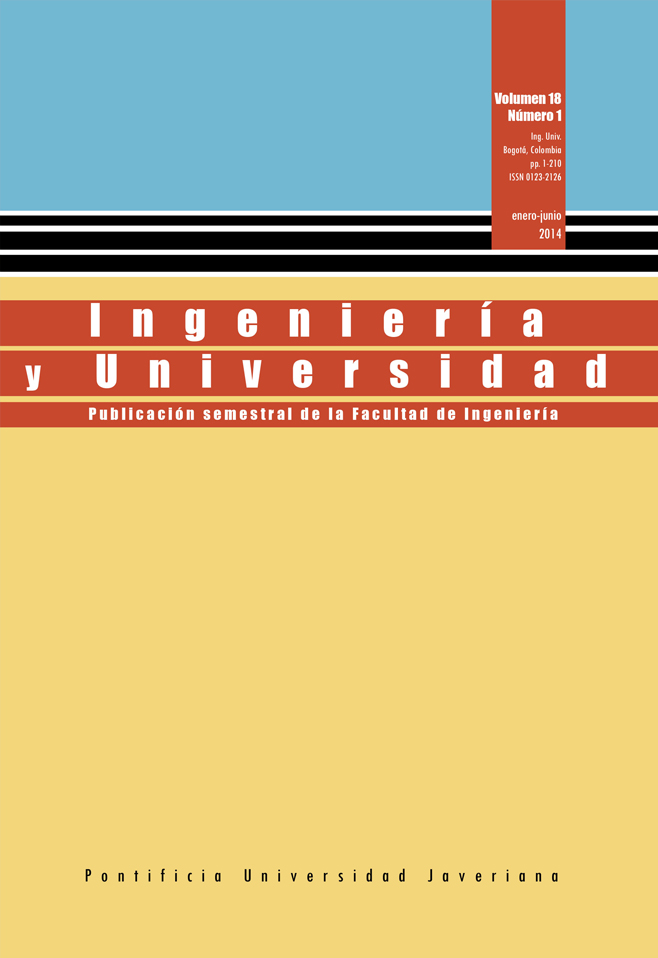Abstract
A diversity of movement patterns may be identified whenstudying a set of moving entities. One of these patterns iscalled V-formation since its shape resembles such letter.Informally, a set of entities shows a V-formation if theyare located in one of its two characteristic lines. In thispaper, we propose a model for identifying V-formationswith outliers in a list of moving entities. An outlier is anentity of the formation that is apart from its characteristiclines. We present the formal rules of our model and analgorithm for detecting outliers. Our model was validatedin NetLogo, a programming and modeling environmentfor simulating natural and social phenomena.
BEHR, T. and GUTING, R. H. Fuzzy spatial objects: An algebra implementation in Secondo. Proceedings of the International Conference on Data Engineering. IEEE Computer Society Press. 1998, 2005, p. 1137.
BEN-GAL, I. Outlier detection. In Data mining and knowledge discovery handbook. New York: Springer, 2005.
CALDERÓN-MEZA, G. and SHERRY, L. Adaptive agents in NAS-wide simulations: A casestudy of CTOP and SWIM. Integrated Communications, Navigation and Surveillance Conference (ICNS). 2011, pp. F6-1-F6-13.
CAÑIZO, J. A.; CARRILLO, J. A. and ROSADO, J. Collective behavior of animals: Swarming and complex patterns. Arbor, 2010, vol. 186, pp. 1035-1049.
CATTIVELLI, F. and SAYED, A.H. Self-organization in bird flight formations using difusión adaptation. Computational Advances in Multi-Sensor Adaptive Processing (CAMSAP), 2009 3rd IEEE International Workshop, 2009. p. 49-52.
DODGE, S.; WEIBEL, R. and LAUTENSCHÜTZ, A. K. Towards a taxonomy of movement patterns. Information Visualization. 2008, vol. 7, nos. 3-4, pp. 240-252.
GUDMUNDSSON, J.; VAN KREVELD, M. and SPECKMANN, B. Efficient detection of motion patterns in spatio-temporal data sets. Proceedings of the 12th annual ACM International workshop on Geographic information systems.ACM, 2004, pp. 250-257.
HAWKINS, D.M.; BRADU, D. and KASS, G.V. Location of several outliers in multipleregression data using elemental sets. Technometrics. 1984, vol. 26, no. 3, pp. 197-208.
LAUBE, P. and IMFELD, S. Analyzing relative motion within groupsoftrackable moving point objects. In Geographic information science. Berlin: Springer, 2002.
MILLER, B.W. et al. Using stylized agent-based models for population–environment research: a case study from the Galápagos Islands. Population and Environment. 2010, vol. 31, no. 6, pp. 401-426.
MORENO, F.; GOMEZ, S. and ECHEVERRY, J. Análisis y detección de formaciones en V [technical report]. Medellín: Universidad Nacional de Colombia, 2013.
MORENO, F.M.; DUITAMA, J.F. and OSPINA, E.C. A method for estimating the position and direction of a Leader. Revista Facultad de Ingeniería Universidad de Antioquia. 2012, no. 62, pp. 11-20.
NATHAN, A. and BARBOSA, V.C. V-like formations in flocks of artificial birds. Artificial Life. 2008, vol. 14, no. 2, pp. 179-188.
PAPADIMITRIOU, S. et al. Loci: Fast outlier detection using the local correlation integral. Proceedings of 19th International Conference on Data Engineering, 2003, pp. 315-326.
RUEDA, A. Para entender la bolsa: financiamiento e inversión en el mercado de valores. Madrid: Thomson, 2005.
SEILER, P.; PANT, A. and HEDRICK, K. Analysis of bird formations. Proceedings of the 41st IEEE Conference on Decision and Control, 2002, pp. 118-123.
SEWATKAR, C. M.; SHARMA, A. and AGRAWAL, A. A first attempt to numerically compute forces on birds in V formation. Artificial Life. 2010, vol. 16, no. 3, pp. 245-258.
SU, H. et al. Adaptive flocking with a virtual leader of multiple agents governed by locally Lipschitz nonlinearity. Nonlinear Analysis: Real World Applications. 2013, vol. 14, no. 1, pp. 798-806.
WILENSKY, U. and RAND, W. Making models match: Replicating an agent-based model. Journal of Artificial Societies and Social Simulation. 2007, vol. 10, no. 4, p. 2.
ZONGYAO, W. and DONGBING, G. Behaviour based fuzzy flocking systems. Proceedings of the IEEE International Conference on Fuzzy Systems. 2007, pp. 1-6.
This journal is registered under a Creative Commons Attribution 4.0 International Public License. Thus, this work may be reproduced, distributed, and publicly shared in digital format, as long as the names of the authors and Pontificia Universidad Javeriana are acknowledged. Others are allowed to quote, adapt, transform, auto-archive, republish, and create based on this material, for any purpose (even commercial ones), provided the authorship is duly acknowledged, a link to the original work is provided, and it is specified if changes have been made. Pontificia Universidad Javeriana does not hold the rights of published works and the authors are solely responsible for the contents of their works; they keep the moral, intellectual, privacy, and publicity rights.
Approving the intervention of the work (review, copy-editing, translation, layout) and the following outreach, are granted through an use license and not through an assignment of rights. This means the journal and Pontificia Universidad Javeriana cannot be held responsible for any ethical malpractice by the authors. As a consequence of the protection granted by the use license, the journal is not required to publish recantations or modify information already published, unless the errata stems from the editorial management process. Publishing contents in this journal does not generate royalties for contributors.


